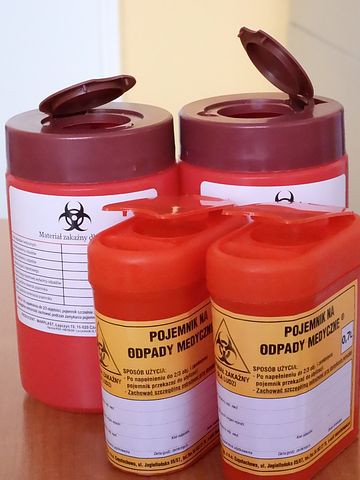.................................................................................................................................................................
Hospital Waste
By: Haseeb Jamal
Hospital
Waste
These
materials can include waste generated by healthcare facilities like clinics,
hospitals, laboratories, medical research facilities, and veterinary clinics.
Medical
waste can contain bodily fluids like blood or other contaminants.
What
is Hospital Waste?
It
is the waste generated during medical research, testing, diagnosis,
immunization, or treatment of either human beings or animals and is also termed
as biomedical waste.
Risk
From Hospital Waste
Persons
at Risk:
All
persons exposed to the hazardous biomedical waste are potentially at risk,
which includes all those who either handle the waste at any stage or are
exposed to it as a consequence of careless management.
Infectious
waste may contain a great variety of pathogenic micro organisms.
These
pathogens contained in the waste may infect the human body through different
ways, which includes:
Absorption
through a cut in the skin
Absorption
through the mucus membrane.
Through
inhalation or ingestion.
Biomedical
infections are a particular concern these days, for which there is a strong
evidence of transmission via the biomedical waste.
Instances
of infections include HIV virus, Hepatitis B and C.
Syringes
and needles are especially very dangerous because they are often contaminated
with patient's blood.
Many
pharmaceuticals used in hospitals are hazardous. They can cause intoxication
from absorption through skin, mucus membrane and from inhalation or ingestion.
Many
catatonic drugs are extremely irritant and produce harmful local effects after
drugs are extremely irritant and produce harmful local effects after direct
contact with the skin or eyes in addition to the more serous genetic effects.
They
can cause dizziness, nausea, headache or dermatitis.
Many
chemicals can be toxic, corrosive, flammable, reactive and explosive or shock
sensitive. The most common injuries are burns.
Contact
with skin, eyes or mucosa of the lung airways can provoke injuries.
Chemical
residues discharged in the sewerage system can affect the working of biological
sewage treatment plants.
Also,
may have toxic effects on the natural ecosystem of recipient waters.
The
type of injury caused by radioactive waste is determined by the type of
exposure.
This
may start from simple dizziness (feeling about to fall), headaches, vomiting
and may lead to genetic effects.
Hazards
from low activity waste may occur from contamination of external surfaces of
contamination of external of containers or improper storage.
Waste
Segregation Guidelines:
The
risk waste should be segregated at the point of generation from Non-risk waste.
It is useful for safe disposal of risks waste.
The
process of segregation at source has two advantages
The
risk waste is separated from non-risk waste which accounts for 20% of the total
medical waste.
At
source segregation minimizes the chances of infection and injury to the persons
who handle the waste.
For
the different types of hospital waste separate containers are required i. e.
risk waste sharps and non-risk waste.
All
the different colored containers lined with plastic bags are placed in each
ward and department.
The
person responsible for waste handling must do source segregation to reduce the
chance of infection and lesser amount of waste to be incinerated.
Segregation
must be practiced from the source of generation to handling, transportation
till the final disposal.
The
following steps should be observed.
All
categories of risk waste other than sharps are collected in "white
color" container lined with plastic bag.
The
bags are sealed and labeled on site with the name of ward and location.
The
sharps are stored in "Red" color hard plastic container lined with a
plastic bag.
The
medical staff cuts the needles of syringes making it unfit for reuse.
If
the sharp container is to be incinerated, it shall be placed in the yellow
waste bag with the other risk waste.
Large
quantities of pharmaceutical waste shall be returned to suppliers. Small
quantities may be placed in a yellow waste bag, preferably after being crushed.
Radioactive
waste may be placed in large yellow container or drum and may be marked with
"Radioactive" waste.
Non-infectious
radioactive waste may be placed in white bags.
The
non-risk waste is stored separate from all other waste and is collected in a
"Blue" container with a plastic bag lining.
The
blue containers should be located in the corridors open spaces and other
visiting places etc.
Container
Specification:
All
the containers in hospital wards and department should be capable of handling
waste with out spillage or puncture.
.
The 40 liters capacity containers well are sufficient for one day storage. The containers will be of hard polyethylene materials.
.
The 40 liters capacity containers well are sufficient for one day storage. The containers will be of hard polyethylene materials.
Haseeb Jamal
I am a Civil Engineer,
graduated from University
of Engineering and Technology, Peshawar, Pakistan in 2010. I also
have a PG-Diploma in Disaster Management and
MS in Urban
Infrastructure Engineering (In Progress). My expertise include civil
related softwares like AutoCAD,
SAP2000, MS Project, Primavera, MS Office and GIS. My technical skills include
project management, monitoring and evaluation, structural assessment, disaster
risk management, Quantity survey, land survey, material testing, site
management and technical writing. I am trained in writing project progress
reports as well as proposals and concept papers. I have also received advanced
training on surveying, proposal writing, Monitoring and Evaluation of projects
as well as organizations.
I have worked as Project
Engineer at National Research and Development Foundation, Peshawar and
CENCON Associates. I also worked with Spectra Engineering Solutions as Senior
Civil Engineer in monitoring of World Bank and UNDP funded projects all
over Khyber Pakhtunkhwa and FATA. Currently, I am working as Deputy
Manager Development at NayaTel, Peshawar.


No comments:
Post a Comment